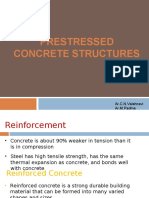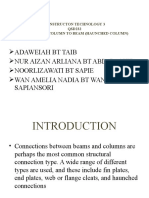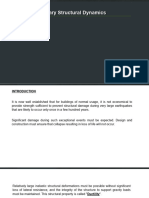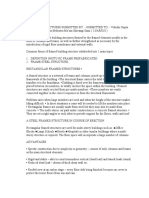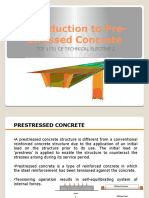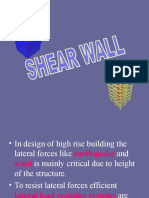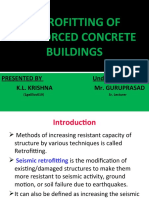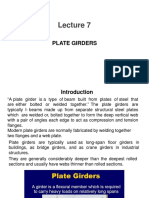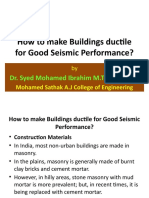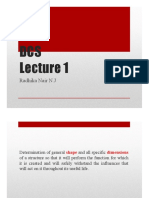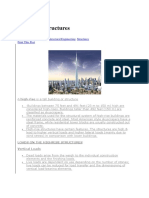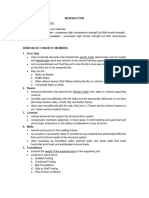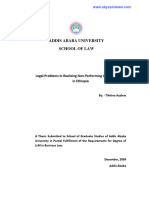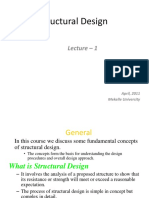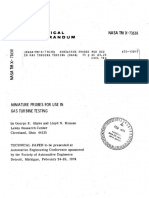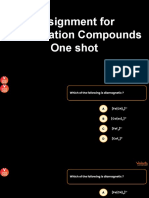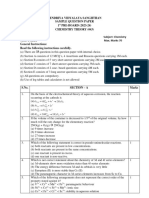0 ratings0% found this document useful (0 votes)
21 viewsCapacity Design
Capacity Design
Uploaded by
Hamlity SaintataCapacity design is a seismic design method that aims to ensure ductile failure by dissipating energy through predetermined, ductile zones. It has two key aspects: 1) ensuring flexural failure at the member level by suppressing brittle shear failure, and 2) establishing a plastic hinge hierarchy at the system level following the strong column-weak beam principle. This allows for a ductile response by forming plastic hinges first in beams and then in columns as lateral forces increase. Confinement reinforcement and shear design are important aspects of capacity design for achieving the necessary ductility.
Copyright:
© All Rights Reserved
Available Formats
Download as PPTX, PDF, TXT or read online from Scribd
Capacity Design
Capacity Design
Uploaded by
Hamlity Saintata0 ratings0% found this document useful (0 votes)
21 views30 pagesCapacity design is a seismic design method that aims to ensure ductile failure by dissipating energy through predetermined, ductile zones. It has two key aspects: 1) ensuring flexural failure at the member level by suppressing brittle shear failure, and 2) establishing a plastic hinge hierarchy at the system level following the strong column-weak beam principle. This allows for a ductile response by forming plastic hinges first in beams and then in columns as lateral forces increase. Confinement reinforcement and shear design are important aspects of capacity design for achieving the necessary ductility.
Original Title
CAPACITY DESIGN
Copyright
© © All Rights Reserved
Available Formats
PPTX, PDF, TXT or read online from Scribd
Share this document
Did you find this document useful?
Is this content inappropriate?
Capacity design is a seismic design method that aims to ensure ductile failure by dissipating energy through predetermined, ductile zones. It has two key aspects: 1) ensuring flexural failure at the member level by suppressing brittle shear failure, and 2) establishing a plastic hinge hierarchy at the system level following the strong column-weak beam principle. This allows for a ductile response by forming plastic hinges first in beams and then in columns as lateral forces increase. Confinement reinforcement and shear design are important aspects of capacity design for achieving the necessary ductility.
Copyright:
© All Rights Reserved
Available Formats
Download as PPTX, PDF, TXT or read online from Scribd
Download as pptx, pdf, or txt
0 ratings0% found this document useful (0 votes)
21 views30 pagesCapacity Design
Capacity Design
Uploaded by
Hamlity SaintataCapacity design is a seismic design method that aims to ensure ductile failure by dissipating energy through predetermined, ductile zones. It has two key aspects: 1) ensuring flexural failure at the member level by suppressing brittle shear failure, and 2) establishing a plastic hinge hierarchy at the system level following the strong column-weak beam principle. This allows for a ductile response by forming plastic hinges first in beams and then in columns as lateral forces increase. Confinement reinforcement and shear design are important aspects of capacity design for achieving the necessary ductility.
Copyright:
© All Rights Reserved
Available Formats
Download as PPTX, PDF, TXT or read online from Scribd
Download as pptx, pdf, or txt
You are on page 1of 30
CAPACITY DESIGN
CAPACITY DESIGN
‘‘Design method in which elements of the
structural system are chosen and suitably
designed and detailed for energy dissipation
under severe deformations while all other
structural elements are provided with
sufficient strength so that the chosen means
of energy dissipation can be maintained’’.
CAPACITY DESIGN
• A dissipative structure is able to dissipate energy by
means of ductile hysteretic behavior at the dissipative
zones, which are the predetermined parts of a dissipative
structure.
• Capacity design has two major implications, one at the
member level, and the other at the system level.
• Member level Flexural failure mode is ensured by
suppressing shear failure (capacity shear principle in
beams, columns, walls and connections).
• System level The spreading of plastic regions that undergo
flexural yielding follows a hierarchy for obtaining a more
ductile system response (strong column–weak beam
principle at the connections).
Ductility
• Actual forces that appear on structures are much higher than
the design force that specified in the code.
• It is recognized that the complete protection of building is
economically not feasible.
• The basic approach of earthquake resistant design is based
upon lateral strength, deformability and ductility capacity of
structure.
• Ductility in the structure will arise from inelastic material
behavior and detailing of reinforcement in such a manner that
brittle failure is avoided and ductile behavior is induced by
allowing steel to yield in controlled manner.
• The primary task of design engineer is is to ensure that
building will posses enough ductility to withstand the size and
type of earthquake.
IMPACT OF Ductility
• Consider a Single degree of freedom system.
• When the ground displaces, if the connection is so rigid the
weight will experience same large force as compared to
ground force
• In case of flexible connection, it will bend and or deform and
the weight will subjected to lesser force because some energy
will be consumed to displace the system.
• Thus ductility is important attribute in earthquake resistant
structure that serves as a shock absorber and reduces the
transmitted force to the structure.
REQUIREMENT OF Ductility
• In order to achieve a ductility we must give stress on two key
areas during the design process.
• First the overall design concept for building configuration
must me sound.
• Second individual members must be designed for ductility and
connection needs special care.
ASSESSMENT OF Ductility
• Ductility is the capability of a material, structural component,
or the entire structure to undergo deformation after its initial
yield without any significant reduction in yield strength.
• Ductility is general measured in terms of ductility ratio or
ductility factor, which is the ratio of the maximum
deformation that a structure or element can undergo without
loss of initial yielding resistance to initial yield deformation
FACTORS AFFECTING DUCTILITY
• Ductility increases linearly with an increase in the shear
strength carried by concrete for small value of axial
compressive stress
• Ductility linearly reduces upto the point where axial
compressive stress becomes equal to the axial compressive
stress at balanced failure.
• With the increase of ultimate strain of concrete, the ductility
factor increases. Thus confining of concrete increases the
ductility appreciably.
• An increase in yield strength of steel with all other variables
constantly decreases ductility. The ductlity increases with
increase in concrete strength.
FACTORS AFFECTING DUCTILITY
• The lateral reinforcement tend to improve ductility by
preventing shear failures, restraining the compression steel
against buckling.
• The lateral reinforcement in the form of closed stirrups is
effective in binding the compressive zone thereby confining
the concrete and increasing the ductility of section.
• Shear failure occurs at smaller deflection than the flexural
failures and hence absorbs much less energy. Members should
be designed and detailed by providing web reinforcement so
that their strength in shear exceeds strength in flexure.
Therefore ductility increases as the stirrups in the specimen
increases.
FACTORS AFFECTING DUCTILITY
• Bond failures and anchorage failures are sudden and brittle.
Special attention must be given in details to prevent them from
occurring in structures, which must behave in ductile manner.
Ductility in Reinforced Concrete Materials
• Triaxial stress state in reinforced concrete members can be
provided with confinement reinforcement.
• When concrete is subjected to axial stress, passive lateral
pressure developed by the lateral tie reinforcement provides
significant increase in strength and enormous increase in the
strain capacity of concrete.
Ductility in Reinforced Concrete Materials
a. Hot rolled steel bar b. Cold worked reinforcing bar
Ductility in Reinforced Concrete Materials
Ductility in Reinforced Concrete Materials
• Strength and deformation capacities of concrete fibers in the
core region of columns increase with the amount of lateral
confinement reinforcement.
• Confinement is most effective in circular columns since lateral
pressure develops uniformly in all radial directions whereas a
rectangular tie is more effective at the corners.
Ductility in Reinforced Concrete Materials
Limitations on Tension Reinforcement
• The momentcurvature relationships of two beam sections with
identical lateral reinforcement and compression reinforcement
ratio that ensure flexural failure mode.
• The only difference is the ratio of tension reinforcement.
• It can be observed that ductility reduces with increase in
tension reinforcement, and 0.02 appears as a reasonable upper
limit for a ductile response.
Minimum Compression Reinforcement
• Compression reinforcement is known to be increasing the
ductility of a beam cross section significantly.
• Moment-curvature relations for beam sections with minimum
tension and lateral reinforcement, but with different
compression reinforcement ratios.
• It is evident that q0/q[0.5 is a reasonable lower limit to ensure
ductility.
Shear Design of Beams
• Shear failure is suppressed by calculating the design shear
force from flexural capacity, but not from analysis.
• Let us consider the free body diagram of a beam carrying
uniformly distributed gravity loading (g + q) along its span.
• When the earthquake moments act on the beam, we will
assume that both end-sections i and j reach their flexural
capacities (with strain hardening) under double flexure.
Shear Design of Beams
• The shear capacity of the beam section Vr is calculated
according to the relevant concrete design standards.
• Further, possible compression strut failure due to
overreinforcing in shear is prevented by the requirement.
Strong Column-Weak Beam
• Flexural plastic hinges inevitably form at the ends of frame
members under design ground motions.
• A plastic hinge formed on a beam is less critical than a plastic
hinge on a column or shear wall, because vertical members
may lose their stability under gravity loads when plastic
hinges form.
• Accordingly, plastic hinge hierarchy requires formation of
plastic hinges first on beams, then at the base of first story
columns.
• A plastic hinging hierarchy can be imposed in design by
proportioning the flexural capacities of beam and column ends
joining at a connection.
• This is called the strong column–weak beam principle.
Strong Column-Weak Beam
Strong Column-Weak Beam
• Strong column-weak beam principle leads to a ductile
collapse strategy under increasing lateral earthquake
forces.
Strong Column-Weak Beam
Strong Column-Weak Beam
Strong Column-Weak Beam
Strong Column-Weak Beam
Strong Column-Weak Beam
Strong Column-Weak Beam
Strong Column-Weak Beam
Strong Column-Weak Beam
You might also like
- Structural Design 101 Structural Detailing of Reinforced Concrete Structures in The Low To Mid Rise CategoryDocument70 pagesStructural Design 101 Structural Detailing of Reinforced Concrete Structures in The Low To Mid Rise CategoryJason Grace100% (2)
- Lecture 1 - Prestressed ConcreteDocument15 pagesLecture 1 - Prestressed ConcreteHasini KadaruNo ratings yet
- Reinforced Concrete Buildings: Behavior and DesignFrom EverandReinforced Concrete Buildings: Behavior and DesignRating: 5 out of 5 stars5/5 (1)
- Ductility by ChinnarajuDocument76 pagesDuctility by ChinnarajuRamen KishoreNo ratings yet
- Pre-Stressing: Pre-Stressed Concrete Member Is ADocument47 pagesPre-Stressing: Pre-Stressed Concrete Member Is AAbu ZaforNo ratings yet
- Ductility 4Document8 pagesDuctility 4reagan omondiNo ratings yet
- Adaweiah BT Taib Nur Aizan Arliana BT Abd. Rashid Noorlizawati BT Sapie Wan Amelia Nadia BT Wan SapiansoriDocument19 pagesAdaweiah BT Taib Nur Aizan Arliana BT Abd. Rashid Noorlizawati BT Sapie Wan Amelia Nadia BT Wan SapiansoriNur Humairak NordinNo ratings yet
- LEC06Document59 pagesLEC06Hamza KhawarNo ratings yet
- Ductile Building DesignDocument3 pagesDuctile Building DesignroseNo ratings yet
- Prestressed Concrete Lecture 1Document33 pagesPrestressed Concrete Lecture 1Talha SiddiquiNo ratings yet
- Framed Structures 1Document4 pagesFramed Structures 1Festus NgumbiNo ratings yet
- Reinforced Cement Concrete (RCC)Document96 pagesReinforced Cement Concrete (RCC)Junaid ShahNo ratings yet
- (Prestressed Concrete) Lecture 03 Dr. ZubairDocument65 pages(Prestressed Concrete) Lecture 03 Dr. ZubairAhmed RiadNo ratings yet
- Ce Technical Elective 2 Lesson 1Document23 pagesCe Technical Elective 2 Lesson 1Christian Jerome A. GeronimoNo ratings yet
- Unit Ii - Design ConceptsDocument85 pagesUnit Ii - Design ConceptsAguero AgueroNo ratings yet
- Shear WallDocument119 pagesShear WallZuzar100% (3)
- Differences of WSD-LSDDocument7 pagesDifferences of WSD-LSDprabhu810% (1)
- Composite BeamsDocument37 pagesComposite BeamsAbdallahNo ratings yet
- Ductility PDFDocument10 pagesDuctility PDFhfgfgNo ratings yet
- Framed Structures: Submitted By:-Submitted ToDocument15 pagesFramed Structures: Submitted By:-Submitted ToNidhi MehtaNo ratings yet
- Prestressed Concrete TerminologiesDocument11 pagesPrestressed Concrete Terminologieselainesiapno82No ratings yet
- Chapter 2 Limit State Design For Flexure: Reinforced Concrete Structures I (Ceng-3111)Document50 pagesChapter 2 Limit State Design For Flexure: Reinforced Concrete Structures I (Ceng-3111)Muaz HararNo ratings yet
- Theory of Structures Assignment FinalDocument21 pagesTheory of Structures Assignment FinalManasAroraNo ratings yet
- Reinforced Cement Concrete - Prof AquibDocument124 pagesReinforced Cement Concrete - Prof AquibarokiaNo ratings yet
- Capacity Design: P.Sudha 1061014 Ii M.E. CmaaseDocument66 pagesCapacity Design: P.Sudha 1061014 Ii M.E. CmaasePraveenkumar Shanmugam100% (1)
- Pre - Stress Concrete: Submitted byDocument16 pagesPre - Stress Concrete: Submitted byTinzar LattNo ratings yet
- Concrete Structures: Temesgen Wondimu, PHD Jimma Institute of Technology Chapter 7: Design For Earthquake ResistanceDocument60 pagesConcrete Structures: Temesgen Wondimu, PHD Jimma Institute of Technology Chapter 7: Design For Earthquake ResistanceabadittadesseNo ratings yet
- Joints and Connections in Precast Structure SystemDocument52 pagesJoints and Connections in Precast Structure Systemnr.husninathirahNo ratings yet
- Pre-Stressed Post Tension ConcreteDocument9 pagesPre-Stressed Post Tension ConcreteManal KhatibNo ratings yet
- Retrofitting of Reinforced Concrete BuildingsDocument44 pagesRetrofitting of Reinforced Concrete BuildingsKrupakl Gowda100% (9)
- Definition of PrestressDocument21 pagesDefinition of PrestressShashank PatoleNo ratings yet
- SRGQ423 - Flexural Design of Prestressed ConcreteDocument41 pagesSRGQ423 - Flexural Design of Prestressed ConcreteGleizel AutorNo ratings yet
- Prestresed Concrete Post Tensioning PDFDocument27 pagesPrestresed Concrete Post Tensioning PDFSathya GajjalaNo ratings yet
- Lecture 7-Plate GirdersDocument44 pagesLecture 7-Plate GirdersBaraka GotoraNo ratings yet
- Ajay SeminarDocument12 pagesAjay SeminarAnkit SharmaNo ratings yet
- Prestressed Concrete Design Lecture NotesDocument52 pagesPrestressed Concrete Design Lecture NotesChristopher John Natividad100% (1)
- Buildingsductilefor Good SeismicDocument14 pagesBuildingsductilefor Good Seismicvaishnavi pawarNo ratings yet
- High Rise StructuresDocument21 pagesHigh Rise StructuresJayamal Induruwa100% (1)
- Structural Response CharacteristicsDocument31 pagesStructural Response CharacteristicsIzet MehmetajNo ratings yet
- Earthquake Resistant Structural System 14.12.2006Document81 pagesEarthquake Resistant Structural System 14.12.2006Vanu VamalaiNo ratings yet
- 1129011951BMCS4Document24 pages1129011951BMCS4DHEESHNA DILEEP 200545No ratings yet
- by MohanDocument31 pagesby Mohanvineela saiNo ratings yet
- Limit State Design of Concrete StructuresDocument76 pagesLimit State Design of Concrete StructuresRadhikaNo ratings yet
- Introduction To ConcreteDocument36 pagesIntroduction To ConcreteNikkie De JesusNo ratings yet
- Prestressed Concrete Design Lecture NotesDocument52 pagesPrestressed Concrete Design Lecture NotesThotho KennedyNo ratings yet
- Earthquake Resistant Building DesignDocument22 pagesEarthquake Resistant Building DesignAnkush BhartiNo ratings yet
- Rc-Ductility Due To EQDocument303 pagesRc-Ductility Due To EQnfaayed100% (1)
- DR KP-JayaDocument7 pagesDR KP-JayaRiyaz SiddiqueNo ratings yet
- Concrete DesignDocument8 pagesConcrete DesigncherogonyaNo ratings yet
- High Rise StructuresDocument21 pagesHigh Rise StructuresChainsmokers ChainsmokersNo ratings yet
- Reinforced Concrete Column 1Document11 pagesReinforced Concrete Column 1reesespufffNo ratings yet
- Pre Fabrication and Pre StressingDocument25 pagesPre Fabrication and Pre StressingIqRa JaVedNo ratings yet
- Post Tensioned SlabDocument38 pagesPost Tensioned Slabmadz heussafNo ratings yet
- Composite Construction Method: Honorio, Jia Faye Kristia C. Quiban, JanelleDocument13 pagesComposite Construction Method: Honorio, Jia Faye Kristia C. Quiban, JanelleJay ReyesNo ratings yet
- PRS ReviewerDocument9 pagesPRS ReviewerRose Diana DecenaNo ratings yet
- Classes 5, 6, 7Document29 pagesClasses 5, 6, 7jorgesida31No ratings yet
- DPSC Mod 1 IntroductionDocument12 pagesDPSC Mod 1 IntroductionKajalNo ratings yet
- Prestressed ConcreteDocument17 pagesPrestressed Concretenikhilarora1988No ratings yet
- Some Mooted Questions in Reinforced Concrete Design American Society of Civil Engineers, Transactions, Paper No. 1169, Volume LXX, Dec. 1910From EverandSome Mooted Questions in Reinforced Concrete Design American Society of Civil Engineers, Transactions, Paper No. 1169, Volume LXX, Dec. 1910No ratings yet
- FPM 1-4Document120 pagesFPM 1-4Hamlity SaintataNo ratings yet
- Chapter FiveDocument29 pagesChapter FiveHamlity SaintataNo ratings yet
- Chapter 4 Deflection and BucklingDocument64 pagesChapter 4 Deflection and BucklingHamlity SaintataNo ratings yet
- Legal Problems in Realizing Non-Performing Loans of BanksDocument99 pagesLegal Problems in Realizing Non-Performing Loans of BanksHamlity SaintataNo ratings yet
- CHAPTER-3 Lateeral Load Resistane System Example - 2Document54 pagesCHAPTER-3 Lateeral Load Resistane System Example - 2Hamlity SaintataNo ratings yet
- Chapter 2Document42 pagesChapter 2Hamlity SaintataNo ratings yet
- Chapter 1Document10 pagesChapter 1Hamlity SaintataNo ratings yet
- Assignment 2Document5 pagesAssignment 2Hamlity SaintataNo ratings yet
- Solid Slab Bridge Design Example 39 2015 - 4-5Document2 pagesSolid Slab Bridge Design Example 39 2015 - 4-5Hamlity SaintataNo ratings yet
- Engineering Mechanics I (Stat) Handout-1-14Document14 pagesEngineering Mechanics I (Stat) Handout-1-14Hamlity SaintataNo ratings yet
- Solid Slab Bridge Design Example 39 2015 - 1-3Document3 pagesSolid Slab Bridge Design Example 39 2015 - 1-3Hamlity SaintataNo ratings yet
- 03 BiosphereDocument37 pages03 BiosphereRonel A GaviolaNo ratings yet
- Motionmountain Volume1 PDFDocument601 pagesMotionmountain Volume1 PDFAngelNo ratings yet
- Activity No.5: Notre Dame of Dadiangas UniversityDocument10 pagesActivity No.5: Notre Dame of Dadiangas Universitydenshang 10No ratings yet
- Imaging of Ferroelectric Domain Walls by Force MicrosDocument4 pagesImaging of Ferroelectric Domain Walls by Force MicrosjohanNo ratings yet
- A308Document4 pagesA308Calidad.comecaranNo ratings yet
- Chap 8Document23 pagesChap 8Ryan MyerNo ratings yet
- US - Acrylate Monomers - Overview Latin AmericaDocument4 pagesUS - Acrylate Monomers - Overview Latin AmericaCurie Industria quimicaNo ratings yet
- Lyondell Basell Moplen EP300RDocument3 pagesLyondell Basell Moplen EP300RHung TranNo ratings yet
- 0620 m18 QP 52 PDFDocument12 pages0620 m18 QP 52 PDFrachitNo ratings yet
- 1 3/27/2013 Prof. Dr. Magdi El-SaadawiDocument22 pages1 3/27/2013 Prof. Dr. Magdi El-SaadawibbhscribdNo ratings yet
- Chemistry Poll 15Document14 pagesChemistry Poll 15PROFESSOR BERLINNo ratings yet
- Thamanna Seminar Report 1Document36 pagesThamanna Seminar Report 1Kmw18 ce013No ratings yet
- Chemical Technician Exam Review: General Chem - SolutionsDocument8 pagesChemical Technician Exam Review: General Chem - SolutionsPrisca Barrientos LimbagNo ratings yet
- Coeficiente de Compresibilidad Isotermica Del Petroleo PDFDocument174 pagesCoeficiente de Compresibilidad Isotermica Del Petroleo PDFAnonymous HJZffHvTNo ratings yet
- Toxicology Compendium PDFDocument602 pagesToxicology Compendium PDFJUANNo ratings yet
- NASA TM X-71638 MemorandumDocument15 pagesNASA TM X-71638 Memorandummohamadhosein mohamadiNo ratings yet
- Chapter 8 X-Ray ProductionDocument3 pagesChapter 8 X-Ray ProductionAnne LimpinNo ratings yet
- Crude Assay - Lecture NotesDocument18 pagesCrude Assay - Lecture Notessam joseph100% (1)
- Materials 14 06309 v2Document14 pagesMaterials 14 06309 v2Linh HungNo ratings yet
- CupruorganometalicDocument12 pagesCupruorganometalicDiana CebotariNo ratings yet
- Mid Term Report Kiln N CoalDocument32 pagesMid Term Report Kiln N CoalKailash NathNo ratings yet
- Alkanes, Alkenes and AlkynesDocument65 pagesAlkanes, Alkenes and AlkynesTeresita CamachoNo ratings yet
- Assignment Coordination One ShotDocument48 pagesAssignment Coordination One ShotRamacharyuluNo ratings yet
- The Earth's Atmosphere - K. Saha PDFDocument374 pagesThe Earth's Atmosphere - K. Saha PDFIvetteNo ratings yet
- Chemistry Project 2Document21 pagesChemistry Project 2hermoine grangerNo ratings yet
- Nafta-Gaz 2021-01 3Document6 pagesNafta-Gaz 2021-01 3Jacek SobczykNo ratings yet
- 9701 w11 QP 52Document12 pages9701 w11 QP 52Zeyuan CaoNo ratings yet
- Homework 1. This Homework Is Based On Chapters: Problem 1Document4 pagesHomework 1. This Homework Is Based On Chapters: Problem 1Iqra WahidNo ratings yet
- Mathcad Functions For Conduction Heat Transfer CalculationsDocument51 pagesMathcad Functions For Conduction Heat Transfer CalculationsExequiel SeguelNo ratings yet
- PB Xii Chem 2023-24Document6 pagesPB Xii Chem 2023-24NehaNo ratings yet

